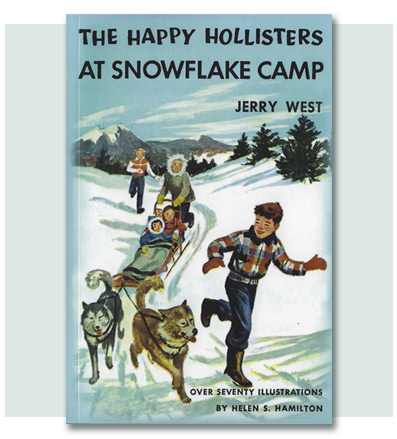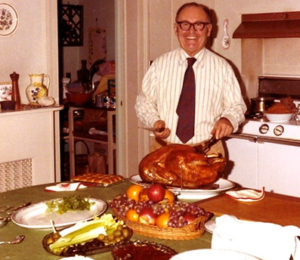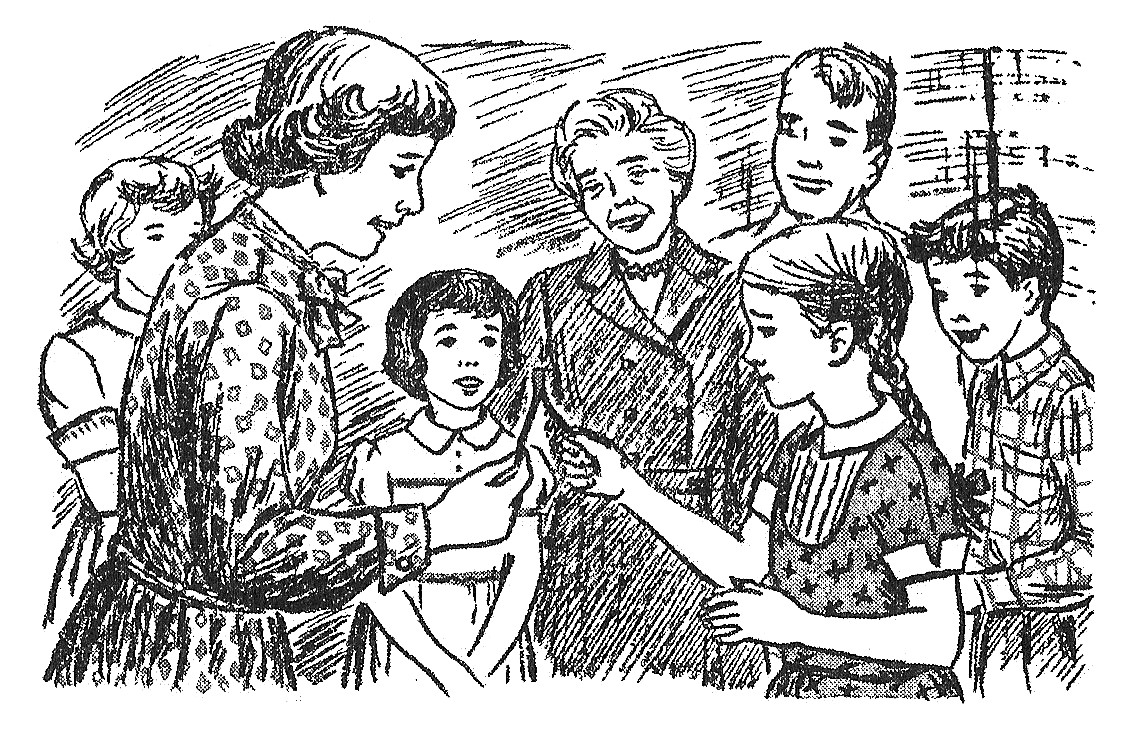
In The Happy Hollisters at Snowflake Camp, the Hollister family travels to Canada and solves the mystery of a missing dog sledder and his valuable puppies. Along with their exciting and unusual exploits, they also do something that many American children do—they celebrate a very traditional Thanksgiving, just as author Andrew Svenson (aka Jerry West) did every year with his family! Spending the Thanksgiving holiday with their grandparents, the Hollisters enjoy a “big gobbler” of a turkey and pumpkin pie, make a wish on the turkey’s wishbone, and gather together to sing Thanksgiving hymns and count their blessings.
 The first American Thanksgiving was celebrated in 1621, a year after the passengers of the Mayflower arrived in the area we now know as Massachusetts. During their first year in the New World, many of the colonists, Pilgrims who left England seeking religious freedom, died from exposure, malnutrition, and illness. However, those who survived avoided disaster with assistance from the Wampanoag, the indigenous people of the area, who were there long before the Mayflower arrived. An alliance with the Wampanoag ensured the Pilgrims’ survival, as the Native Americans taught them how to harvest corn and other local crops. In November of 1621, the Pilgrims and the Wampanoag celebrated their first successful harvest with a three-day feast, now regarded as the first Thanksgiving.
The first American Thanksgiving was celebrated in 1621, a year after the passengers of the Mayflower arrived in the area we now know as Massachusetts. During their first year in the New World, many of the colonists, Pilgrims who left England seeking religious freedom, died from exposure, malnutrition, and illness. However, those who survived avoided disaster with assistance from the Wampanoag, the indigenous people of the area, who were there long before the Mayflower arrived. An alliance with the Wampanoag ensured the Pilgrims’ survival, as the Native Americans taught them how to harvest corn and other local crops. In November of 1621, the Pilgrims and the Wampanoag celebrated their first successful harvest with a three-day feast, now regarded as the first Thanksgiving.
Lovers of modern Thanksgivings dinners would probably be alarmed by the menu of the first Thanksgiving in 1621. While it’s not fully known what the Pilgrims and Wampanoag enjoyed during their feast, turkey and pumpkin pie probably weren’t on the table! Butter, wheat, and sugar were scarce, which meant that lavish desserts were unlikely, but their feast likely included pumpkins and other types of squash, along with fruits like plums, cranberries, and grapes. Instead of turkey, meats might have included duck, geese, deer, seal, or fish. The menu for the first Thanksgiving might be a little different than modern Thanksgiving feasts, but for the Pilgrims, it probably all still tasted great after a long and brutal first winter in America.
Thanksgiving, as it came to be called, wasn’t celebrated as a national holiday until 1863, under the presidency of Abraham Lincoln—likely an attempt to promote peace and brotherhood at the height of the Civil War. Lincoln is also associated with another Thanksgiving tradition: the presidential turkey pardon. He is said to be the first president who decided to spare the life of a turkey presented to him at Thanksgiving. The turkey pardon didn’t become an official White House tradition until John F. Kennedy’s administration in the early 1960s, but since then, every president has officially pardoned a turkey, sparing it from the oven and sending it to live out its natural life on a farm.
Along with the presidential turkey pardon, many other Thanksgiving traditions have developed throughout the years, like parades and football. Many families gather around the television on Thanksgiving morning to watch the festive and extravagant Macy’s Thanksgiving Day Parade, which began in 1924. Football is also often watched on Thanksgiving, a tradition that dates all the way back to 1876 when spectators watched a Thanksgiving Day match between Ivy-League colleges Yale and Princeton. Professional football got into the act in 1934, and today the NFL presents several Thanksgiving Day games, which traditionally feature the Detroit Lions and the Dallas Cowboys.
Thanksgiving isn’t unique to Americans, though. Readers of The Happy Hollisters at Snowflake Camp learn that it’s also an important holiday in Canada. However, there a few key differences between the way Americans and Canadians celebrate Thanksgiving. In Canada, the earliest Thanksgiving celebration commemorated the treacherous ocean voyage and eventual safe arrival of British explorer Sir Martin Frobisher in northeastern Canada in 1578. Canadian Thanksgiving is now celebrated on October 12th in all provinces and territories except New Brunswick, Nova Scotia, and Prince Edward Island. Like Americans, many Canadian celebrate their Thanksgiving with family dinners, football, and parades, though their festivities are generally smaller than they are in the United States. Their traditional meals also often differ from ours, and what is on the plate often depends on the province or territory. For example, people in Newfoundland might enjoy a “Jiggs dinner” consisting of boiled meat with split pea pudding, and in Ontario, butter tarts take the place of pumpkin pie.
No matter what traditions your family honors on Thanksgiving Day, it remains a lovely day to spend quality time with family—watch the parade and a little football and overindulge with a big meal of traditional family favorites (maybe followed by a nap!). Maybe a read-aloud session of The Happy Hollisters at Snowflake Camp could even become a part of your Thanksgiving tradition!
By Libby Svenson Kennedy
Sources:
Research Notes, Andrew Svenson Archives of The Hollister Family Properties Trust
https://www.history.com/topics/thanksgiving/history-of-thanksgiving
https://www.whitehousehistory.org/pardoning-the-thanksgiving-turkey
https://www.history.com/news/why-do-americans-watch-football-on-thanksgiving

